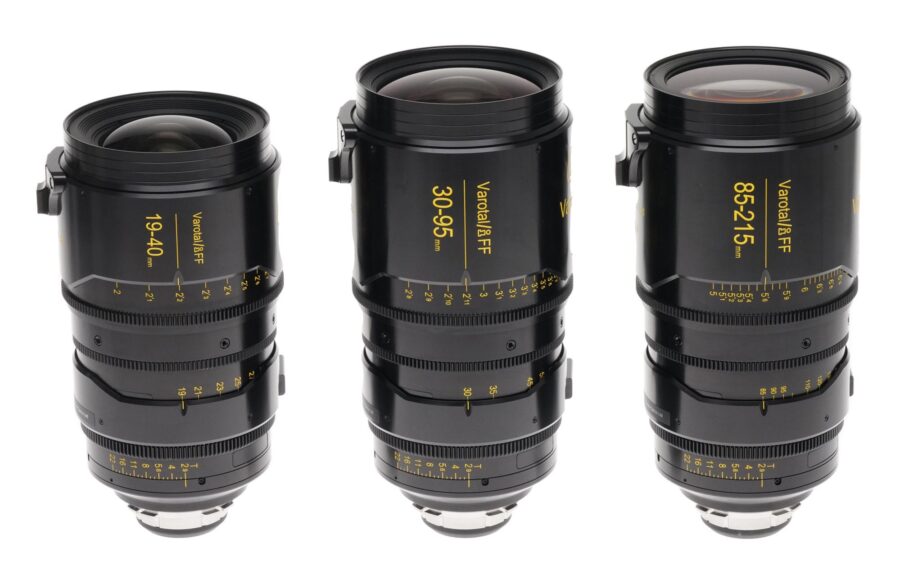1932. Cooke Varo 40-120mm Variable Focal (Zoom) Lens.
Arthur Warmisham was the optical designer (British patent 398,307) of one of the first commercially manufactured vari- able focal (zoom) lenses for cinematography. The Cooke Varo 40-120mm cine lens for 35mm format was assembled and sold by Bell & Howell. It came equipped with a special cradle that held the Varo lens and the camera together to ensure correct alignment. Focal length was changed by rotating a crank.
1971. Cooke Varotal 20-100mm, f2.8 / T3.1 Zoom.
Designed by Gordon H. Cook, this was Cooke’s first high- quality zoom lens for 35mm motion picture cameras. Its design remained central to the concept for Cooke zooms produced through the 1990s. It had a sealed front focus unit and fixed front element that eliminated the risk of dirt and moisture being drawn into the lens, did not rotate or trombone in and out,
and allowed for convenient fitting of a mattebox. It had anti- reflective wide-band Varomag high-performance coatings. This increased shadow area definition, light transmission, durability, and reduced ghosting and flares. Originally fitted with an ARRI bayonet mount, most now have a retrofit PL mount (developed by ARRI in 1982).
1975. Cooke Cine Varotal 25-250mm f2.8 / T3.1 Zoom.
Cooke’s first 10:1 long range zoom lens for 35mm.
The print magazine headline by Alastair Riach, Cooke’s great ad-man at the time, was, “The Cooke Varotal is the first motion picture zoom lens not to be designed on the principle of a bicycle pump.”
1981. Cooke Varo-Panchro 20-60mm T3.1 Zoom.
The concept was optical performance comparable to prime lenses. This was my first Varotal on a brand-new Arriflex 35- BL3, a young Jon Fauer and a young Tom Cruise on All the Right Moves in 1983. Mud, rain, night exterior, and lots of low angles in the mud. Tom Stern, ASC, was the gaffer, ringing the stadium in Johnstown, PA with lots of Musco lights but we were still wide open with a wrench at T3.1.
The Varo-Pancrho was unique. It was the first zoom I had ever seen that didn’t breathe. You could rack focus from a close-up low angle to the far-away crowd and the image did not shift. And because of all the mud and rain, changing prime lenses was not practical. Its 3x zoom range covered wide to mid-range. And so, the Varotal worked as a zoomable prime, not because we didn’t want to zoom but because we didn’t have time to use primes.
1983. Cooke Cine Varotal 25-250mm T3.9 Mark II Zoom.
There were 2 versions of the Mk II 25-250: focus barrel in front, and zoom in front with focus at the rear (early Panavision style).
1986. Cooke Wide Angle Varotal, 14-70mm T3.1 Zoom.
During the development stage in the mid-1980s, customers’ in- put prompted the company to incorporate a curved front cover glass and a noise isolator. This lens was unique in the zoom series because it included a wide angle aspheric element.
1987. Cooke Varotal 18-100mm T3 Zoom.
Design was initiated at the beginning of 1987 and the lens was exhibited for the first time at Photokina in 1988. It included refinements prompted by suggestions from cinematographers and camera operators. It became very popular.
1992. Cooke Cinetal 25-250mm T3.7 Mark III Zoom
1998 – 2021. Zoom Time Out.
Cooke stopped building 35mm cine zooms by around 1998 (with the exception of the short and fast 15-40mm T2.0 CXX S4i in 2006 and a video camera version of the 18-100.
2021. Cooke Varotal/i Full Frame 30-95 and 85-215 T2.9 Zooms.
Cooke introduced Full Frame 30-95mm T2.9 and 85-215mm T2.9 Varotal/i FF Zooms in November 2021.
2022. Cooke Varotal/i FF 30-95 T2.9 and 85-215 T2.9 Zooms.
Cooke introduces Full Frame 19-40mm T2.9 Varotal/i.


















